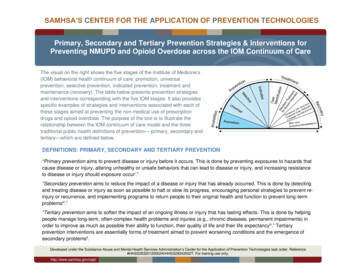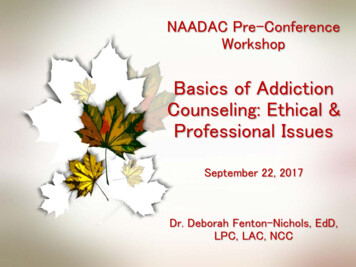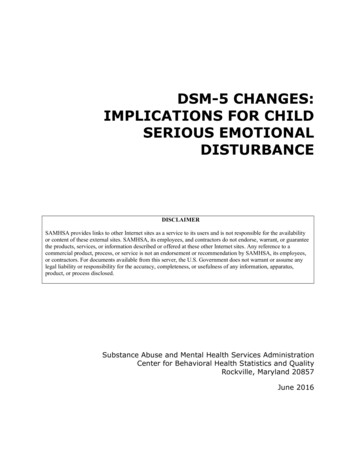
Transcription
SAMHSA’S CENTER FOR THE APPLICATION OF PREVENTION TECHNOLOGIESPrimary, Secondary and Tertiary Prevention Strategies & Interventions forPreventing NMUPD and Opioid Overdose across the IOM Continuum of CareThe visual on the right shows the five stages of the Institute of Medicine’s(IOM) behavioral health continuum of care: promotion, universalprevention, selective prevention, indicated prevention, treatment andmaintenance (recovery). The table below presents prevention strategiesand interventions corresponding with the five IOM stages. It also providesspecific examples of strategies and interventions associated with each ofthese stages aimed at preventing the non-medical use of prescriptiondrugs and opioid overdose. The purpose of the tool is to illustrate therelationship between the IOM continuum of care model and the threetraditional public health definitions of prevention— primary, secondary andtertiary—which are defined below.DEFINITIONS: PRIMARY, SECONDARY AND TERTIARY PREVENTION“Primary prevention aims to prevent disease or injury before it occurs. This is done by preventing exposures to hazards thatcause disease or injury, altering unhealthy or unsafe behaviors that can lead to disease or injury, and increasing resistanceto disease or injury should exposure occuri.”“Secondary prevention aims to reduce the impact of a disease or injury that has already occurred. This is done by detectingand treating disease or injury as soon as possible to halt or slow its progress, encouraging personal strategies to prevent reinjury or recurrence, and implementing programs to return people to their original health and function to prevent long-termproblemsiii.”“Tertiary prevention aims to soften the impact of an ongoing illness or injury that has lasting effects. This is done by helpingpeople manage long-term, often-complex health problems and injuries (e.g., chronic diseases, permanent impairments) inorder to improve as much as possible their ability to function, their quality of life and their life expectancyiii.” Tertiaryprevention interventions are essentially forms of treatment aimed to prevent worsening conditions and the emergence ofsecondary problemsii.Developed under the Substance Abuse and Mental Health Services Administration’s Center for the Application of Prevention Technologies task order. Reference#HHSS283201200024I/HHSS28342002T. For training use only.http://www.samhsa.gov/capt/
SAMHSA’S CENTER FOR THE APPLICATION OF PREVENTION TECHNOLOGIESPromotionStrategiesDescriptions ofstrategies andinterventionsacross thebehavioralhealthcontinuum ofcareStrategies targetthe generalpublic and/orentire populationand aim toenhanceindividuals’ability to achievedevelopmentallyappropriatecompetenciesand a positivesense of selfesteem,mastery, andwell-beingSecondaryInterventionsPrimary StrategiesUniversal PreventionIndirect Universal Prevention:Strategies target the generalpublic and/or an entirepopulation that has not beenidentified on the basis ofindividual risk, by changingthe social context thatinfluences knowledge,attitudes and behaviorDirect Universal Prevention:Strategies target the generalpublic and/or an entirepopulation that has not beenidentified on the basis ofindividual risk. Strategies aredirected to everyone in thatgroup.SelectivePreventionStrategies targetindividuals or apopulation subgroup whose riskof developingsubstance use ormental healthdisorders issignificantlyhigher thanaverage (prior tothe diagnosis of adisorder)IndicatedPreventionInterventionstarget individualsat high risk whohave minimal butdetectable signsor symptoms ofsubstance use ormental healthdisorders (prior tothe diagnosis of adisorder)Tertiary etindividualsdiagnosed withsubstance useproblems, andmay includefacilitating entryintodetoxification,outpatienttreatment, inpatienttreatment, ormedicationassistedtreatment sofurther disabilityis minimizediiiInterventionstargetindividuals intreatment forsubstanceuse problemsor aftertreatment iscompletedand nalrehabilitationprograms andrecoverysupportgroupsDeveloped under the Substance Abuse and Mental Health Services Administration’s Center for the Application of Prevention Technologies task order. Reference#HHSS283201200024I/HHSS28342002T. For training use only.http://www.samhsa.gov/capt/
SAMHSA’S CENTER FOR THE APPLICATION OF PREVENTION TECHNOLOGIESPrimary StrategiesPromotionStrategiesExamples ofstrategies andinterventionsrelated topreventing nonmedical use ofprescriptiondrugsPromotingemotional selfregulation andpositive schooland communityengagementamongadolescentsUniversal PreventionIndirect UniversalPrevention: Implementationand enforcement ofprescription drug misuseprevention policies inschoolsDirect UniversalPrevention: Education forphysicians on prescriptiondrug misuse andpreventative prescribingpracticesPublic serviceannouncement educationcampaigns to increaseawareness of prescriptiondrug icatedPreventionClinician-facilitatedgroups focusingon support, goalsetting andmonitoring foradolescents athigh risk forprescription drugmisuseScreening,consultation, andreferral for olderadults admitted tohospitals forcomplicationsrelating toprescription druginteractionsCoordinating withprescription drugmonitoringprograms to limitoverprescribing iewing withhigh school youththat have beendiagnosed withalcohol usedisorders andhave initiatedprescription drugmisuseTertiary InterventionsTreatmentFacilitatingentry assistedtreatment andcasemanagementCollaborate withoutpatientsubstance usetreatmentproviders toidentifyadditional casemanagementneeds for wraparound servicesMaintenanceSupportgroups forindividuals inrecoveryaimed topreventrelapselocated incommunitysites onprograms forindividuals inrecoverydesigned toenhancepsychosocialfunctioningand developcoping skillsDeveloped under the Substance Abuse and Mental Health Services Administration’s Center for the Application of Prevention Technologies task order. Reference#HHSS283201200024I/HHSS28342002T. For training use only.http://www.samhsa.gov/capt/
SAMHSA’S CENTER FOR THE APPLICATION OF PREVENTION TECHNOLOGIESPrimary StrategiesExamples ofstrategies andinterventionsrelated onStrategiesSocial marketingcampaignsaimed atreducing stigmaand improvingaccess to careand educatingthe generalpublic aboutaddictionUniversal PreventionIndirect UniversalPrevention: Providinguniversal access toNaloxone by standing orderat pharmacies or throughother distribution sites thatdo not require identificationof use of opioids or arelationship with someonewho is using opioidsDirect UniversalPrevention: Rolling out aplan to equip firstresponders and bystanderswith naloxone, particularlyin high-need communitiesDisseminating informationto the community aboutoverdose risk when usingopioids in combination withother prescriptions andsubstancesSelectivePreventionTargeted trainingon alternative painmanagementtechniques andstrategies toreduce use of andsubsequentdependence onopioid drugs tomanage pain andthereby reducerisk for opioidoverdoseOutreachprograms to thosewho currentlymisuse and abuseopioids toreinforce safe-usemessages ondependence onTargeted trainingfor active users ofopioids, familymembers andpeers on overdoseprevention andreversal strategiesat needleexchangeprograms, supportgroups or drop incentersCollaborating withmethadonemaintenanceprograms todistribute naloxoneto participants/clientsTertiary InterventionsTreatmentLinkingoverdosevictims inemergencyrooms withrecoverycoaches whocan assist inidentifyingtreatmentoptionsPartnering withdetoxificationfacilities toreachindividuals thatuse opioids,their familiesand closeassociates tooffer support inaccessingtreatmentresources, asneededMaintenanceFacilitatingpeer supportopportunitiesfor those inrecovery y supportgroups thatenablemembers toshareapproachesfor providingsupport toloved ones inrecoveryDeveloped under the Substance Abuse and Mental Health Services Administration’s Center for the Application of Prevention Technologies task order. Reference#HHSS283201200024I/HHSS28342002T. For training use only.http://www.samhsa.gov/capt/
SAMHSA’S CENTER FOR THE APPLICATION OF PREVENTION TECHNOLOGIESPrimary StrategiesPromotionStrategiesExamples ofstrategies andinterventionsrelated ued)Universal PreventionDirect Universal PreventionProviding tips to opioidusers on risk reductionstrategies for overdose (forexample, avoid mixingprescription medications, donot drink alcohol while erventionsIndicatedPreventionTargeted trainingand education tothose who havepreviouslyoverdosed andtheirfriends/families onrisk reductionstrategies,including naloxoneuseTertiary InterventionsTreatmentMaintenanceInstitute for Work & Health. (n.d.) What Researchers Mean by primary, secondary and tertiary prevention. Accessed online and-tertiary-preventionii National Institute on Alcohol Abuse and Alcoholism. (2005). Module 3: Preventing Alcohol Abuse and Dependence Accessed onlinefrom: le3Prevention/mODULE3.HTMLiii National Institute on Drug Abuse. (n.d.). Diagnosis & Treatment of Drug Abuse in family Practice. Accessed online ment/diagnosis7.htmliDeveloped under the Substance Abuse and Mental Health Services Administration’s Center for the Application of Prevention Technologies task order. Reference#HHSS283201200024I/HHSS28342002T. For training use only.http://www.samhsa.gov/capt/
The visual on the right shows the five stages of the Institute of Medicine's (IOM) behavioral health continuum of care: promotion, universal prevention, selective prevention, indicated prevention, treatment and maintenance (recovery). The table below presents prevention strategies and interventions corresponding with the five IOM stages.











